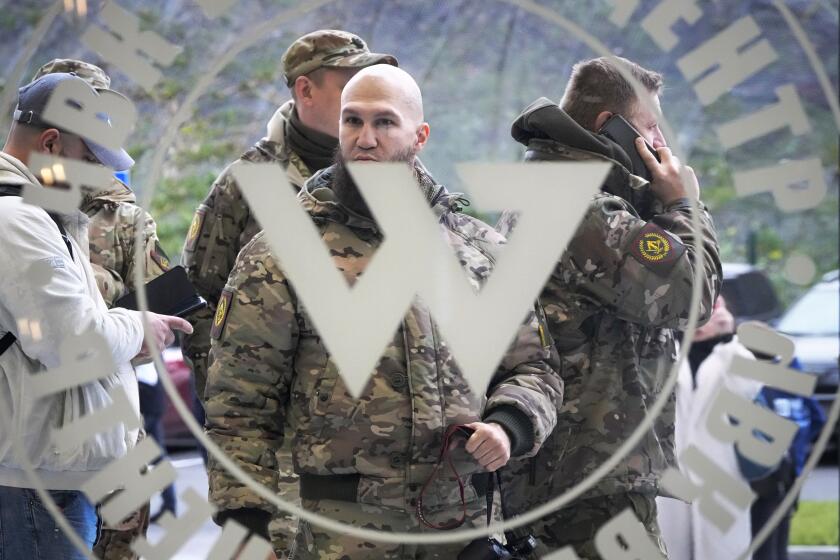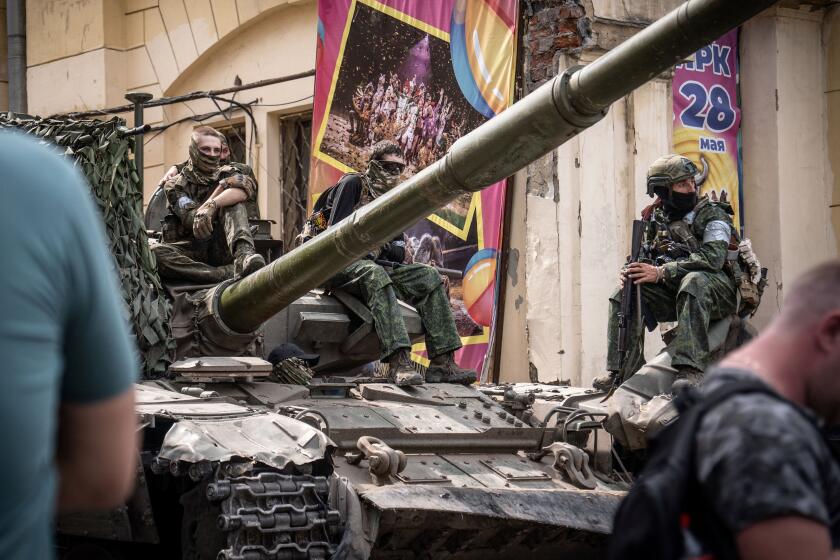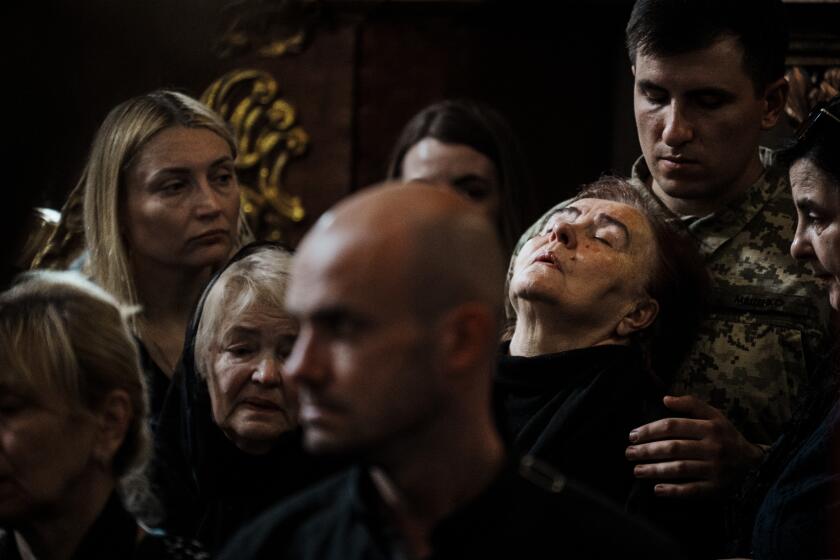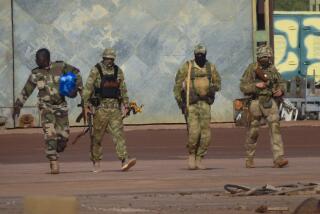Video appears to show Wagner chief Prigozhin for first time since brief mutiny
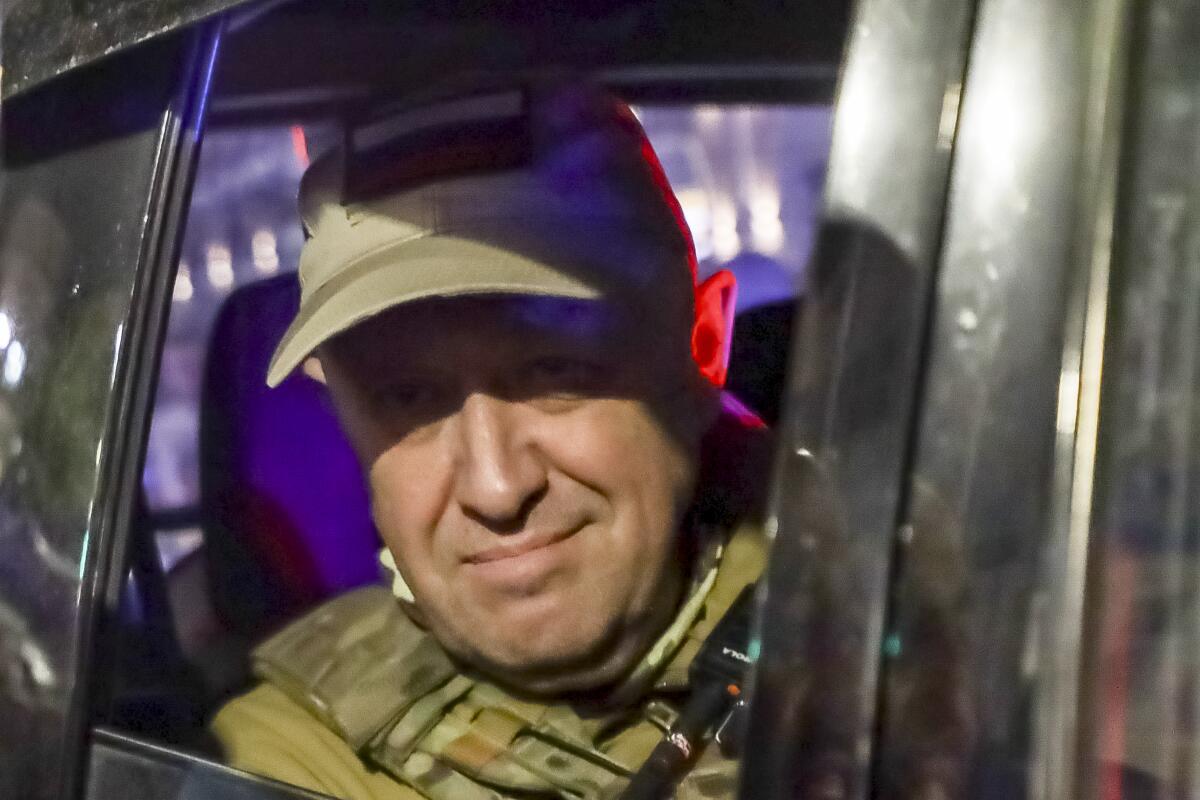
- Share via
MOSCOW — A video released this week appears to show Russian mercenary chief Yevgeny Prigozhin for the first time since he led a short-lived rebellion last month, and he is seen telling his troops they will spend some time in Belarus training its military before deploying to Africa.
A day later, mercenaries from his Wagner private military company launched joint drills with the Belarusian military. The Belarusian Defense Ministry said weeklong drills would take place at a firing range near Brest, a city on the Polish border.
Messaging app channels linked to Wagner said Prigozhin spoke at a field camp in Belarus, and on Wednesday ran a blurry video purporting to show him there, his silhouette seen against the sky at dusk. His gravelly voice was clearly distinguishable.
“Welcome, guys! I am happy to greet you all. Welcome to the Belarusian land!” the video showed him saying. “We fought with dignity! We have done a lot for Russia.”
Prigozhin’s mutiny, which posed the most serious threat to President Vladimir Putin’s 23-year rule, was billed by the mercenary chief as being aimed at ousting Russia’s top military leaders whom he accused of incompetence.
Prigozhin’s criticism of the conduct of the fighting in Ukraine was repeated in the new video, the authenticity of which could not be immediately verified.
“What is going on at the front line today is a shame in which we shouldn’t take part,” he said, adding that Wagner forces could return to Ukraine in the future.
“We may return to the special military operation when we feel sure that we will not be forced to put shame on ourselves,” Prigozhin said, using the Kremlin’s wording for the fighting in Ukraine.
Russian private military contractor Wagner is busy boosting its brand as its fighters try to subdue Ukraine, trading secrecy for war propaganda movies.
“We need to wait for the moment when we can show ourselves in full,” he said. “That is why a decision has been made that we would spend some time here in Belarus. During that time, we will make the Belarusian army the second strongest army in the world. We will train, raise our level and set off for a new journey to Africa.”
In addition to their involvement in Ukraine, Wagner mercenaries have been sent to Syria and several African countries since the private army was created in 2014.
Under the deal that was brokered by Belarusian President Alexander Lukashenko, Prigozhin agreed to end his rebellion in exchange for an amnesty for him and his fighters and permission to relocate to Belarus.
The prospect of a nuclear-armed superpower falling into disarray terrified neighboring countries throughout Europe and put the White House on alert.
Before moving to Belarus, Wagner handed over its weapons to the Russian military, part of efforts by Russian authorities to defuse the threat posed by the mercenaries.
Until the video was posted Wednesday, Prigozhin had released only a couple of audio messages after the mutiny — in contrast with an almost-daily barrage of blustery statements before the events of June 23 and 24. Some saw that as a sign the deal obliged him to cut his rhetoric and stay away from politics.
Belaruski Hajun, an activist group that monitors troops movements in Belarus, said several convoys with Wagner fighters have entered the country since last week, including at least 170 vehicles on Tuesday. It estimated that about 2,500 Wagner mercenaries are now in Belarus.
On Monday, a messaging app channel linked to the contractor ran a video showing Russian and Wagner flags lowered at the mercenaries’ main home base in Molkino in the Krasnodar region of southern Russia. The channel said that the base would close July 30, and one of the mercenaries in the video declared that Wagner was moving to unspecified new locations. Wagner has also used camps in the Russian-occupied Luhansk region of Ukraine.
Even far from Ukraine’s front lines, military funerals set off waves of mourning. ‘You can’t see an end to it,’ one chaplain says as the war drags on.
Prigozhin presented the flag to cheering mercenaries in the video posted Wednesday.
He said Belarusians met them “not only like heroes, but like brothers” and added to their laughter that “local girls are whispering full of desire that Wagner troops have come. Be accurate not to offend any of them, let’s treat them in a brotherly way.”
Lukashenko has said that his country’s military could benefit from the mercenaries’ combat experience and rejected claims that their presence could destabilize the ex-Soviet nation. Last week, Belarusian state TV broadcast video of Wagner instructors training Belarus’ territorial defense forces.
In his revolt that began June 23 and lasted less than 24 hours, Prigozhin’s mercenaries swept through the southern Russian city of Rostov-on-Don and captured the military headquarters there without firing a shot, before moving as close as 125 miles from Moscow.
The mutiny faced little resistance and the mercenaries downed at least six military helicopters and a command post aircraft, killing at least 10 airmen.
Prigozhin had called it a “march of justice” to oust Defense Minister Sergei Shoigu and General Staff chief Gen. Valery Gerasimov, who demanded that Wagner forces sign contracts with the Defense Ministry. He ordered his troops back to their camps after striking the deal to end the rebellion, the terms of which have remained murky.
Putin has declared that Wagner troops have a choice to either sign on with the Defense Ministry, move to Belarus or retire from service. He said last week that he met with Prigozhin and 34 Wagner officers on June 29 and offered them the option of continuing to serve as a single unit under their same commander.
More to Read
Sign up for Essential California
The most important California stories and recommendations in your inbox every morning.
You may occasionally receive promotional content from the Los Angeles Times.
